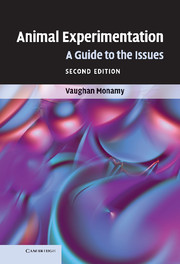Book contents
- Frontmatter
- Contents
- Preface to the second edition
- Acknowledgements
- 1 Issues in animal experimentation
- 2 A history of animal experimentation
- 3 Opposition to animal experimentation
- 4 The moral status of animals
- 5 Animal use
- 6 The regulation of experiments
- 7 Seeking alternatives
- 8 Conclusions
- Ethical guidelines for students in laboratory classes involving the use of animals or animal tissues
- References
- Index
3 - Opposition to animal experimentation
Published online by Cambridge University Press: 05 June 2012
- Frontmatter
- Contents
- Preface to the second edition
- Acknowledgements
- 1 Issues in animal experimentation
- 2 A history of animal experimentation
- 3 Opposition to animal experimentation
- 4 The moral status of animals
- 5 Animal use
- 6 The regulation of experiments
- 7 Seeking alternatives
- 8 Conclusions
- Ethical guidelines for students in laboratory classes involving the use of animals or animal tissues
- References
- Index
Summary
How absurd, … to say that beasts are machines, devoid of knowledge and feeling, which perform all their operations in the same manner, which learn nothing, which perfect nothing, etc! … Barbarians seize this dog, which surpasses man so greatly in his capacity for friendship; they nail him to a table, and dissect him alive to show you the mesenteric veins. You discover in him the same organs of feeling that are in yourself. Answer me, machinist, has nature arranged all the springs of feeling in this animal in order that he should not feel? Has he nerves in order to be unmoved? Do not suppose such a pointless contradiction in nature.
Voltaire ((1764) 1962, pp. 112–13)INTRODUCTION
Opposition to the use of animals for research purposes is not an entirely modern phenomenon. As the number of experiments had increased over time, so too had resistance to them. In western countries, rigid controls are now in force to prevent ill-considered exploitation of laboratory animals (see Chapter 6). These regulations had their origins in nineteenth-century Britain where opposition to painful animal experiments culminated in far-reaching legislation. The 1876 Cruelty to Animals Act ensured for the first time that the welfare of laboratory animals was a legitimate consideration. It is of value to examine the reasons for the enabling of such legislation, and much of the ensuing discussion is derived from the British experience.
- Type
- Chapter
- Information
- Animal ExperimentationA Guide to the Issues, pp. 15 - 34Publisher: Cambridge University PressPrint publication year: 2009



